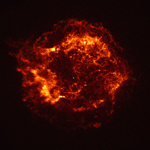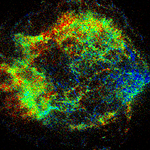CXC Home | Search | Help | Image Use Policy | Latest Images | Privacy | Accessibility | Glossary | Q&A
Cas A in Context

X-ray image of Cas A
NASA/CXC/SAO

X-ray image of Cas A
Image courtesy Gordon Garmire,
Penn State U & the ACIS Team.
The study of remnants of exploded stars, or supernovas, is essential for our understanding of the origin of life on Earth. The cloud of gas and dust that collapsed to form the Sun, Earth and other planets was composed mostly of hydrogen and helium, with a small amount of heavier elements such as carbon, nitrogen, oxygen and iron. The only place where these and other heavy elements necessary for life are made, is deep in the interior of a massive star. There they remain until a catastrophic explosion spreads them throughout space.
About every fifty years in our galaxy, a massive star explodes. The shell of matter thrown off by the supernova creates a bubble of multi-million degree Celsius gas called a supernova remnant. Cas A is a prime example. The hot gas will expand and produce X-rays for thousands of years.
Return to Cassiopeia A (26 Aug 99)


